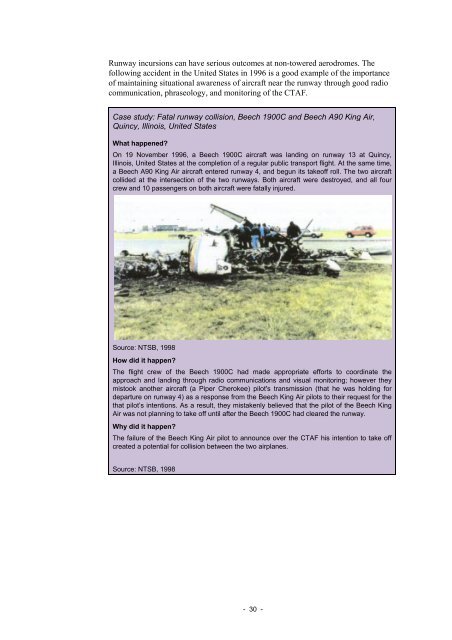Safety in the vicinity of non-towered aerodromes - Australian ...
Safety in the vicinity of non-towered aerodromes - Australian ...
Safety in the vicinity of non-towered aerodromes - Australian ...
Create successful ePaper yourself
Turn your PDF publications into a flip-book with our unique Google optimized e-Paper software.
Runway <strong>in</strong>cursions can have serious outcomes at <strong>non</strong>-<strong>towered</strong> <strong>aerodromes</strong>. The<br />
follow<strong>in</strong>g accident <strong>in</strong> <strong>the</strong> United States <strong>in</strong> 1996 is a good example <strong>of</strong> <strong>the</strong> importance<br />
<strong>of</strong> ma<strong>in</strong>ta<strong>in</strong><strong>in</strong>g situational awareness <strong>of</strong> aircraft near <strong>the</strong> runway through good radio<br />
communication, phraseology, and monitor<strong>in</strong>g <strong>of</strong> <strong>the</strong> CTAF.<br />
Case study: Fatal runway collision, Beech 1900C and Beech A90 K<strong>in</strong>g Air,<br />
Qu<strong>in</strong>cy, Ill<strong>in</strong>ois, United States<br />
What happened?<br />
On 19 November 1996, a Beech 1900C aircraft was land<strong>in</strong>g on runway 13 at Qu<strong>in</strong>cy,<br />
Ill<strong>in</strong>ois, United States at <strong>the</strong> completion <strong>of</strong> a regular public transport flight. At <strong>the</strong> same time,<br />
a Beech A90 K<strong>in</strong>g Air aircraft entered runway 4, and begun its take<strong>of</strong>f roll. The two aircraft<br />
collided at <strong>the</strong> <strong>in</strong>tersection <strong>of</strong> <strong>the</strong> two runways. Both aircraft were destroyed, and all four<br />
crew and 10 passengers on both aircraft were fatally <strong>in</strong>jured.<br />
Source: NTSB, 1998<br />
How did it happen?<br />
The flight crew <strong>of</strong> <strong>the</strong> Beech 1900C had made appropriate efforts to coord<strong>in</strong>ate <strong>the</strong><br />
approach and land<strong>in</strong>g through radio communications and visual monitor<strong>in</strong>g; however <strong>the</strong>y<br />
mistook ano<strong>the</strong>r aircraft (a Piper Cherokee) pilot's transmission (that he was hold<strong>in</strong>g for<br />
departure on runway 4) as a response from <strong>the</strong> Beech K<strong>in</strong>g Air pilots to <strong>the</strong>ir request for <strong>the</strong><br />
that pilot’s <strong>in</strong>tentions. As a result, <strong>the</strong>y mistakenly believed that <strong>the</strong> pilot <strong>of</strong> <strong>the</strong> Beech K<strong>in</strong>g<br />
Air was not plann<strong>in</strong>g to take <strong>of</strong>f until after <strong>the</strong> Beech 1900C had cleared <strong>the</strong> runway.<br />
Why did it happen?<br />
The failure <strong>of</strong> <strong>the</strong> Beech K<strong>in</strong>g Air pilot to announce over <strong>the</strong> CTAF his <strong>in</strong>tention to take <strong>of</strong>f<br />
created a potential for collision between <strong>the</strong> two airplanes.<br />
Source: NTSB, 1998<br />
- 30 -
















